6. Public Key Infrastructure
Public Key Infrastructure
The central idea is that, you can use the public key to encrypt the message that you want to send but only the owner with the private key are able to decrypted the message and actually see the message that is intended for them. If the attacker is able to perform a man in the middle attack, the attacker can only see a bunch of encrypted random bits
RSA

Public Key
To encrypt a message we raise the message to the public key e and take the modulo n
select large prime p and q, where
where
Decrypting
The private key is d is the multiplicative inverse of
Multiplicative inverse
Using the extended Euclidian algorithm
Using PKI
We use PKI to establish a chain of trust for us to know that the party that we want to communicate with is actually the person that we want to communicate with but not some man in the middle.
Digital signature
You can use your private key to sign a message to form a digital signature and everyone can use this digital signature and decrypt it using the public key to decrypt the digital signature to verify the actual person
Public Key
You can use public key to encrypt a message and only the party of the matching private key is able to decrypt the message
Client-server example
In client-server architecture, the server holds a private key and corresponding public key. The client, on the other hand, holds its own private key and public key. The CA acts as an intermediary that verifies and vouches for the authenticity of these keys.
When a client wants to establish a connection with the server, it first requests the server's public key from the CA. The CA then validates the server's identity and signs the server's public key with its own private key. This signed certificate is sent back to the client.
Upon receiving the certificate, the client can verify its authenticity using the CA's public key, which is usually pre-installed on most devices. If the certificate is valid, it means that the server is who it claims to be.
Next, during an initial handshake process called "SSL/TLS handshake," both parties exchange their respective public keys. The client encrypts a random session key using the server's public key and sends it back to establish a secure communication channel.
The server decrypts this session key using its private key, ensuring that only it can access this shared secret. From this point onwards, all communication between client and server is encrypted using symmetric encryption algorithms using this session key.
Getting a certificate from CA
Step 1: Generate a Private Key
The first step is to generate a public/private key pair for the certificate. This private key will be used to sign the certificate request.
openssl genprsa -aes128 -out keypair.pem 2048
-aes128 meant to encrypt the output file using AES(128 bits)
keypair.pem contains both private and public keys
2048 is the RSA key size
Step 2: Create a Certificate Signing Request (CSR)
The next step is to create a Certificate Signing Request (CSR) using the private key generated in step 1. The CSR contains information about the entity requesting the certificate, such as its name, organization, and public key.
openssl req -new -key keypair.pem -out bank.csr
This command creates a new CSR using the key pair from step 1 and saves it in the file "bank.pem".
-key option specifies the path to the private key used for signing.
Step 3 CA issuing X.509 Cetificate
We will send the csr file to the CA and it will verify that we are the actual owner of the key pair. if the verification is successful, the CA will issue a certificate
openssl ca -in bank.csr -out banke_cert.pem -md sha256 -cert modelCA_cert.pem -keyfile modelCA_key.pem
bank.csr is the csr file that we generated previously
bank_cert.pem is the X.509 certificate
modelCA_cert.pem CA's self-signed certificate
modelCA_key.pem CA's private key
Mitigating MITM
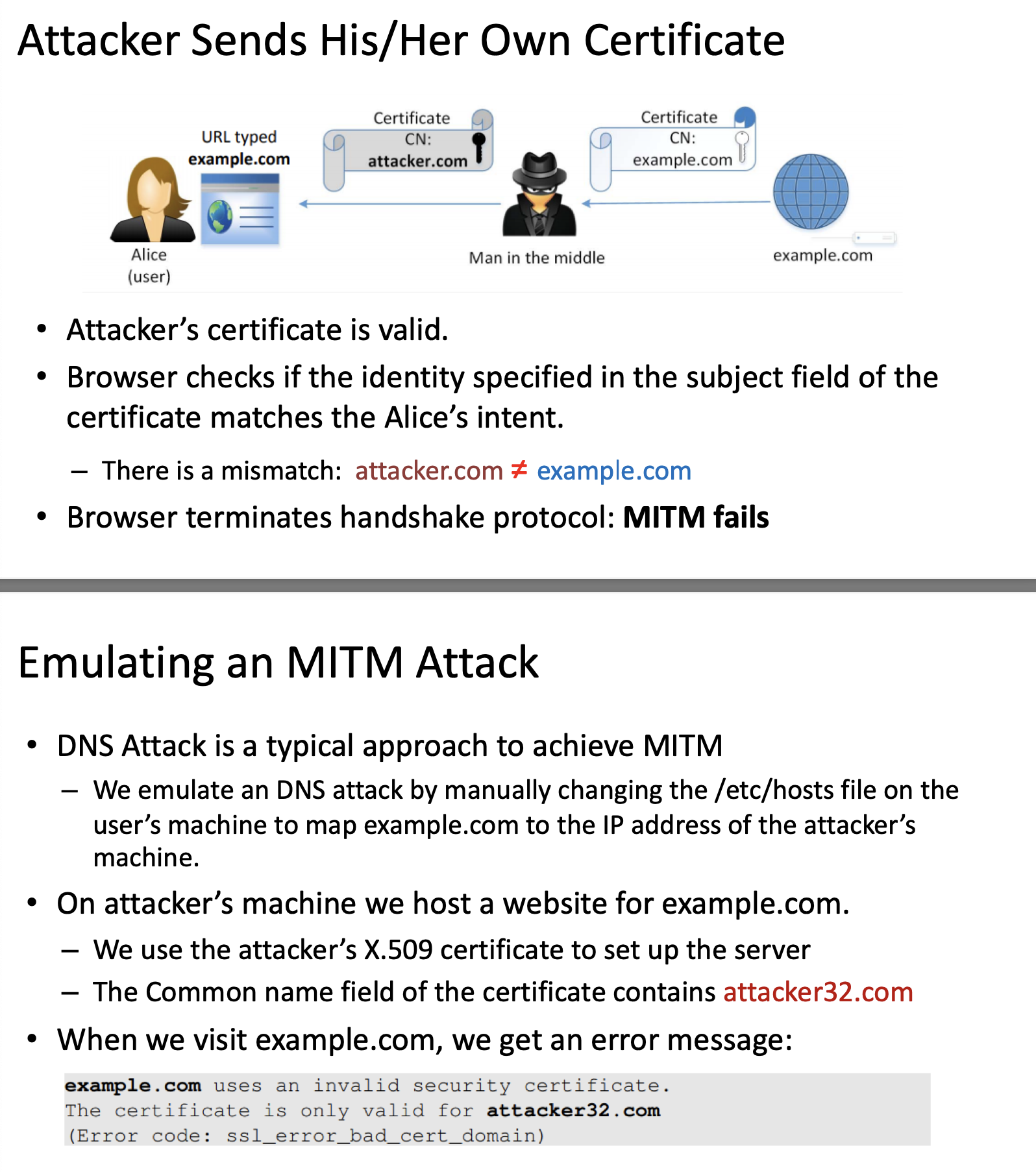
Verifying common name
During TLS/SSL handshake browsers conduct two important validations
- Checks whether the received certificate is valid or not.
- Verifies whether the subject (Common Names) in the certificate is the
sameas the hostname of the server.
Not verifying the common name is a common mistake in software
Attacks Surfaces on PKI
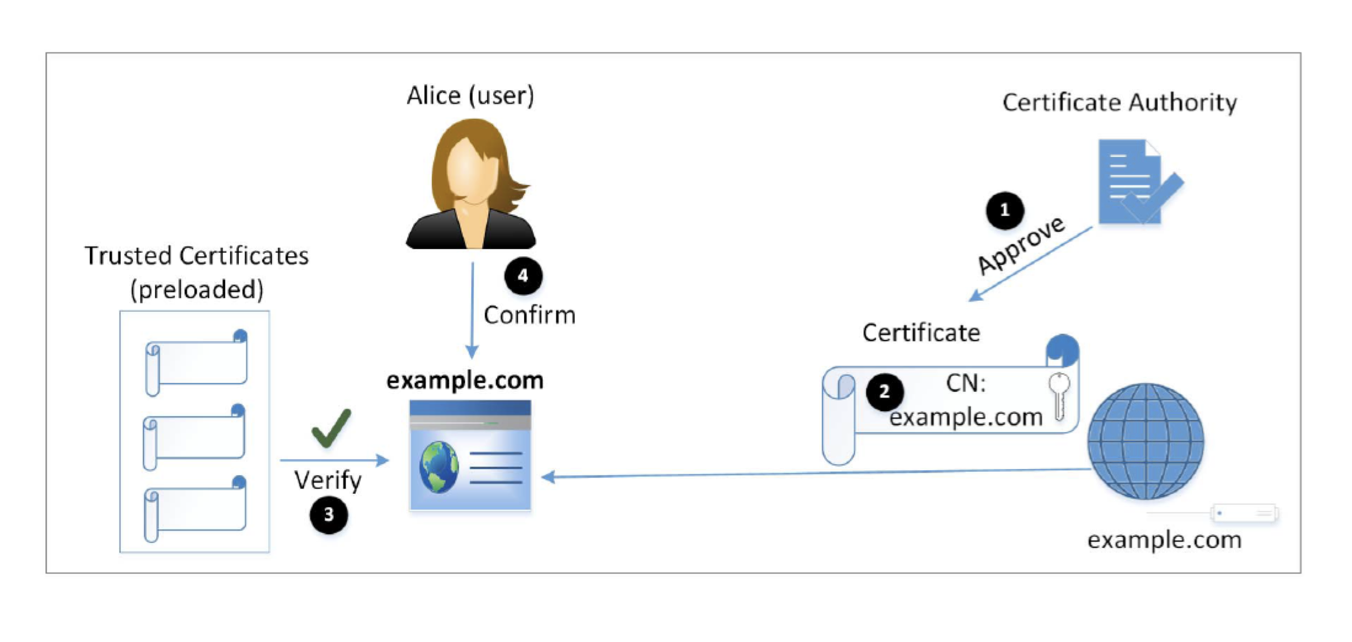
list out the 4 attack surfaces for PKI and what are its consequences and how they can be potentially be compromised
Attack on CA's Verification process
CA’s job has two parts:
- Verify the relationship between certificate applicant and the subject information inside the certificate
- Put a digital signature on the certificate
Attack on CA's signing process
- If the CA’s private key is compromised, attackers can sign a certificate with any arbitrary data in the subject field.
Attacks on Algorithms
Digital Certificates depend on two types of algorithms
- one-way hash function and digital signature
If the algorithm is not collision resistant, the attacker can forge a fake certificate and use the certificate to impersonate the user
If any one is able to crack the encryption algorithm, then the encryption is not secured
Attacks on User Confirmation
- After verifying the certificate from the server, client software is sure that the certificate is valid and authentic
- In addition, the software needs to confirm that the server is what the user intends to interact with.
- Confirmation involves two pieces of information
- information provided or approved by use (eg. domain name)
- the common name field inside the server's certificate
Types of digital certificates
- Domain Validated Certificates (DV)
- Organizational Validated Certificates(OV)
- Extended Validated Certificates (EV)
Domain Validated Certificates (DV)
The CA verifies that the domain record belongs to the applicant
Domain Control Validation is performed on domain name in the certificate request
DCV uses information in the WHOIS database
DCV is conducted via
- HTTP
- DNS
Organizational Validated Certificates(OV)
Not a very popular type of certificate and the CAs will have to verify the the organizations's record and chekc that the organization is legitamate
Extended Validated Certificates (EV)
The EV certificates require documents that are legally signed from registration authorities
cost higher but trustworthy
Transport Layer Security
TLS is a protocol that provides a secure channel between two communicating application
- Confidentiality
- Nobody other than the two ends of the channel can see the actual content of the data transmission
- Integrity
- The channel can detect any changes made to the data during transmission
- Authentication
- At least one end of the channel needs to be authenticated for the other to know who it is talking to
It sits betweenTransportandApplicationLayer
- At least one end of the channel needs to be authenticated for the other to know who it is talking to
- Unprotected data is given to TLS by application layer
- TLS handles encryption, decryption and integrity checks
- TLS gives protected data to Transport layer
TLS handshake
- Before a client and server can communicate securely, several things need to be set up first:
- Encryption algorithm and key
- MAC algorithm
- Algorithm for key exchange
- Exchange the methods in which a secure communication can happen
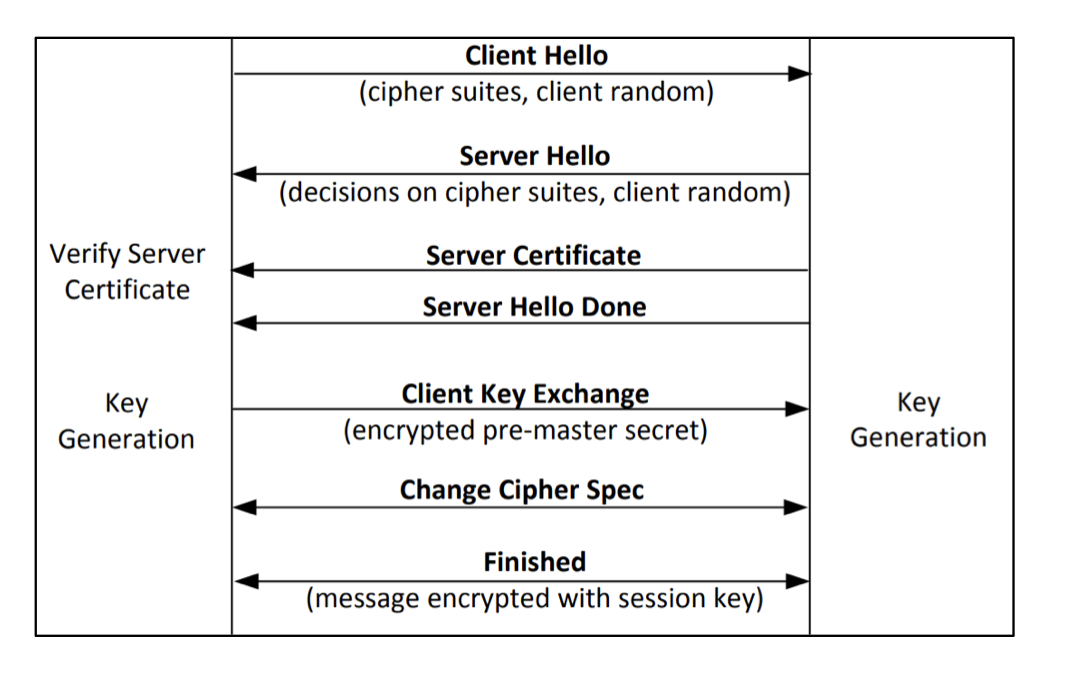
client hello and server hello is in plain text
the pre-master secret is encrypted using the server public key
Wireshark inspection of TLS

Key generation and Exchange
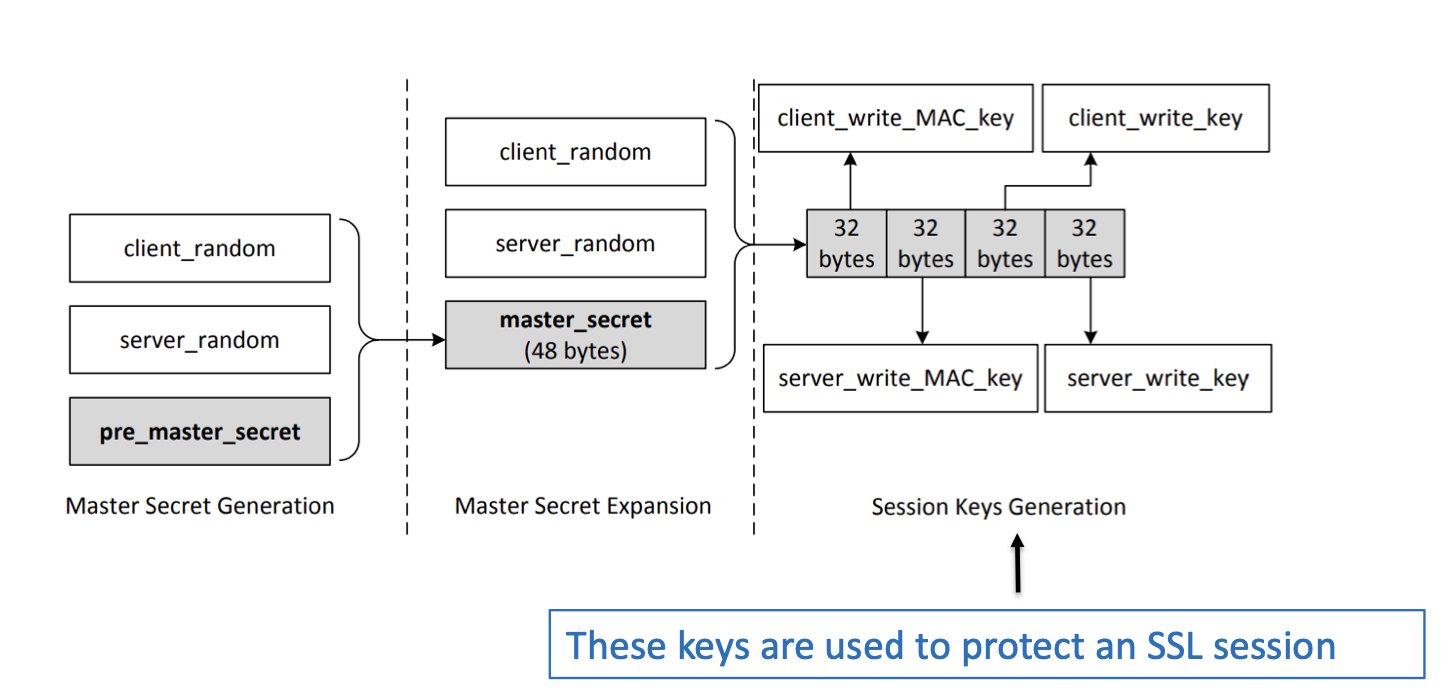
client and server random is send in the hello message
everything in grey is encrypted
The SSL session key is a symmetric encryption key that is used to encrypt and decrypt data exchanged between the client and server during an SSL session. The steps involved in SSL session key generation and exchange are as follows:
-
Client Hello: The SSL handshake process begins with the client sending a "Client Hello" message to the server. This message includes the SSL version supported by the client, a random number called "Client Random," and a list of cipher suites supported by the client.
-
Server Hello: Upon receiving the "Client Hello" message, the server responds with a "Server Hello" message. This message includes the SSL version selected for the session, another random number called "Server Random," and the chosen cipher suite from the client's list.
-
Certificate Exchange: The server sends its digital certificate to the client in order to authenticate itself. The certificate contains information about the server's identity, including its public key.
-
Client Key Exchange: After verifying and validating the server's certificate, the client generates its own random number called "Pre-Master Secret." The client encrypts this Pre-Master Secret using the server's public key obtained from its certificate and sends it to the server.
-
Server Key Exchange: If necessary (e.g., for certain cipher suites), the server may respond with its own encrypted Pre-Master Secret or additional information required for key exchange.
-
Master Secret Generation: Both parties independently generate a Master Secret using their respective random numbers (Client Random, Server Random) along with other negotiated parameters during this handshake.
-
Session Key Generation: Using algorithms like HMAC (Hash-based Message Authentication Code), PRF (Pseudo-Random Function), and the Master Secret, the client and server independently derive the session keys. These session keys are unique to each SSL session and are used for encrypting and decrypting data during the session.
-
Change Cipher Spec: The client and server notify each other that subsequent messages will be encrypted using the newly generated session keys.
-
Finished Message: To verify that both parties have successfully derived the same session keys, they exchange "Finished" messages. These messages contain a hash of all previous handshake messages, encrypted using the session keys. If these
TLS Data Transmission
Once the handshake protocol is finished, client and server can start exchanging data
Data is transferred using records
Each record contains a header and payload

- Fragmentation: The sending party breaks down application data into manageable blocks, known as fragments. Each fragment is processed separately.
- Compression (Deprecated in TLS 1.3): In older versions of TLS (prior to 1.3), the fragment could be compressed to reduce the amount of data transmitted. Due to vulnerabilities like CRIME, compression is no longer used in TLS 1.3.
- Encryption:
- A sequence number is associated with each fragment. The sequence number is incremented for every record transmitted.
- A Message Authentication Code (MAC) is computed for the fragment. The MAC provides integrity and authentication for the data. The computation includes the sequence number, ensuring the order of records.
- The fragment and the MAC are then encrypted using symmetric encryption with the derived session keys (from the handshake process). The encryption ensures confidentiality.
- In TLS 1.3, a new construction called "Authenticated Encryption with Associated Data" (AEAD) is used, which combines encryption and authentication into a single step.
- Record Protocol: The encrypted fragment (now termed a "record") is then transmitted with a header. The header indicates the content type (e.g., application data, alert) and the version of TLS in use.
- Reception and Decryption by Recipient:
- Upon receiving the record, the recipient decrypts the content using the shared session key.
- The recipient verifies the MAC to ensure the integrity and authenticity of the data. If the MAC doesn't match, the record is rejected.
- In the case of older TLS versions that used compression, the decrypted fragment would be decompressed to retrieve the original application data.
SSL Write
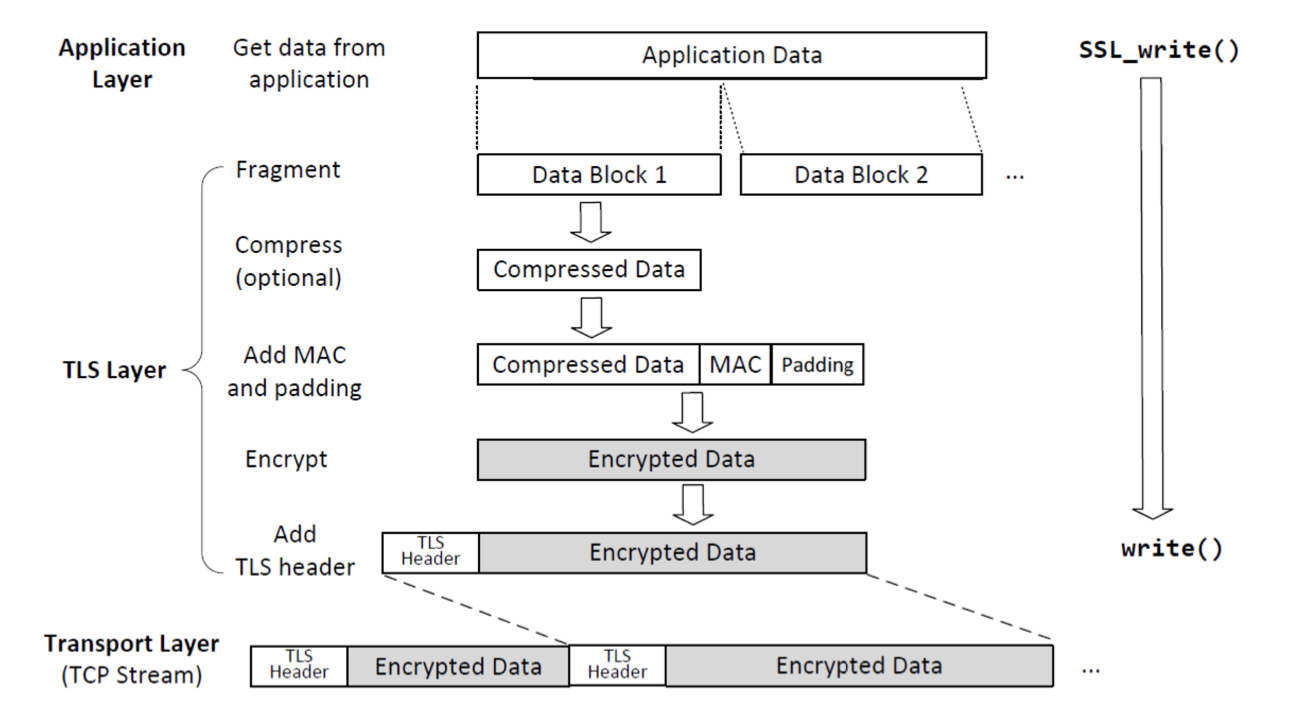
what are the steps in SSL write, starting from getting the data from the application layer to sending the packet to the transport layer
-
The SSL protocol is implemented in the application layer of the network stack. When data needs to be sent securely, it is first obtained from the application layer.
-
The data is then divided into small chunks called records. Each record typically contains a fragment of the original data along with some SSL-specific headers.
-
The SSL protocol then applies compression (if enabled) to reduce the size of the data, making it more efficient to transmit.
-
Next, SSL encryption is applied to the compressed data using a symmetric encryption algorithm such as AES or 3DES. This ensures that the data cannot be read by any unauthorized parties.
-
In addition to encryption, SSL also provides integrity through message authentication codes (MACs). A MAC is generated by applying a cryptographic hash function to the encrypted record and a secret key shared between the client and server.
-
The encrypted and authenticated record, along with any necessary SSL-specific headers, is then encapsulated into a transport layer packet such as TCP/IP or UDP.
-
Finally, this packet is passed down to the transport layer for transmission over the network. It will be delivered to its destination where it will go through a similar process in reverse order for decryption and verification at the receiving end.
SSL read
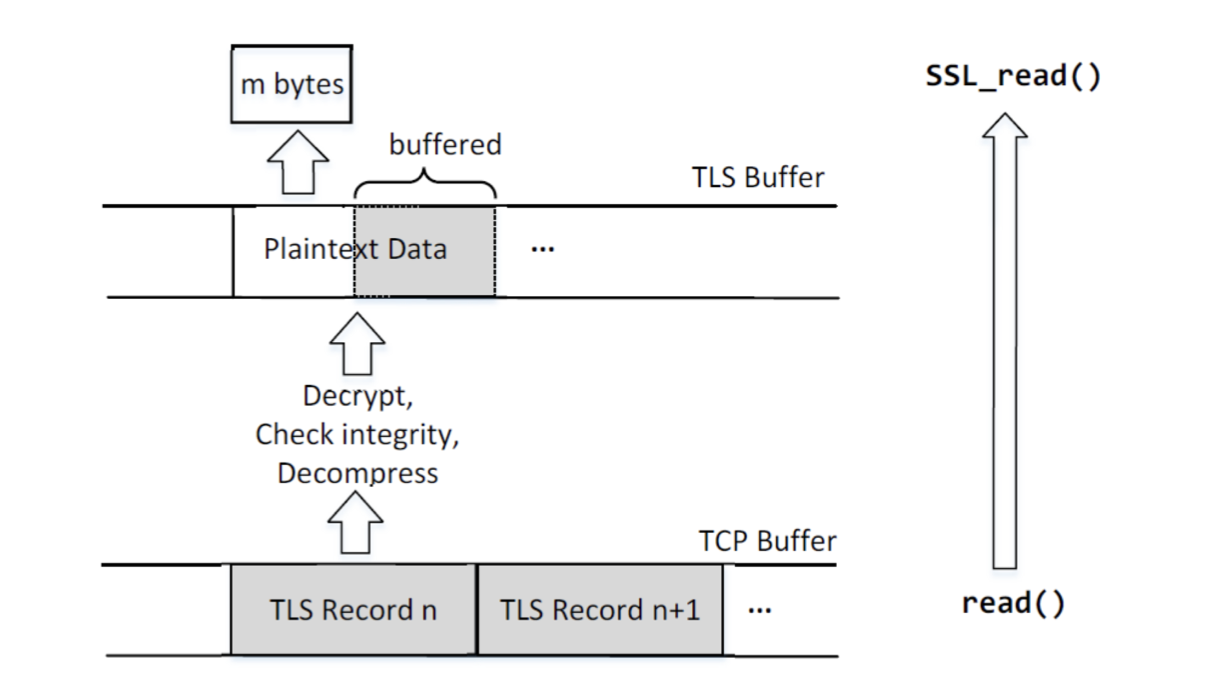
- The recipient uses its session keys to decrypt and verify integrity of the received data using symmetric encryption algorithms specified in the chosen cipher suite.
- If decryption or integrity check fails, an error is raised, and the connection may be terminated.
- If decryption and integrity check succeed, the recipient extracts and processes the plaintext application data from the decrypted payload.
- The SSL read process continues until all encrypted data has been processed or until an end-of-message indicator is received.
TLS Program
Client program
write a tls client program using c
Sure! Below is an example of a TLS client program written in C using OpenSSL:
#include <stdio.h>
#include <stdlib.h>
#include <unistd.h>
#include <string.h>
#include <arpa/inet.h>
#include <sys/socket.h>
#include <openssl/ssl.h>
#include <openssl/err.h>
#define SERVER_IP "127.0.0.1"
#define SERVER_PORT 443
int main() {
SSL_CTX *ctx;
SSL *ssl;
int sockfd;
struct sockaddr_in server_addr;
// Initialize OpenSSL library
SSL_library_init();
ERR_load_crypto_strings();
SSL_load_error_strings();
// Create a new SSL context
ctx = SSL_CTX_new(TLSv1_2_client_method());
// Load the trust store to verify server's certificate
if (!SSL_CTX_load_verify_locations(ctx, "/etc/ssl/certs/ca-certificates.crt", NULL)) {
fprintf(stderr, "Error loading trust store.\n");
exit(1);
}
// Create a new socket
sockfd = socket(AF_INET, SOCK_STREAM, 0);
// Configure server address
memset(&server_addr, 0, sizeof(server_addr));
server_addr.sin_family = AF_INET;
server_addr.sin_port = htons(SERVER_PORT);
if (inet_pton(AF_INET, SERVER_IP, &(server_addr.sin_addr)) <= 0) {
fprintf(stderr, "Invalid address/ Address not supported\n");
exit(1);
}
// Connect to the server
if (connect(sockfd, (struct sockaddr*)&server_addr, sizeof(server_addr)) != 0) {
fprintf(stderr, "Connection failed.\n");
exit(1);
}
// Create a new SSL connection using the socket and context
ssl = SSL_new(ctx);
SSL_set_fd(ssl, sockfd);
// Perform the SSL handshake with the server
if (SSL_connect(ssl) != 1) {
fprintf(stderr, "SSL Handshake failed.\n");
exit(1);
}
// Send data to the server
char message[] = "Hello, server!";
SSL_write(ssl, message, strlen(message));
// Receive data from the server
char buffer[1024];
int bytes_received = SSL_read(ssl, buffer, sizeof(buffer));
TLS Server program
write a TLS server program in c
Sure, here's an example of a TLS server program written in C:
#include <stdio.h>
#include <stdlib.h>
#include <string.h>
#include <unistd.h>
#include <arpa/inet.h>
#include <sys/socket.h>
#include <openssl/ssl.h>
#include <openssl/err.h>
#define SERVER_CERT "server.crt"
#define SERVER_KEY "server.key"
void init_openssl() {
SSL_load_error_strings();
OpenSSL_add_ssl_algorithms();
}
void cleanup_openssl() {
EVP_cleanup();
}
SSL_CTX* create_context() {
const SSL_METHOD *method;
SSL_CTX *ctx;
method = TLS_server_method();
ctx = SSL_CTX_new(method);
if (!ctx) {
perror("Unable to create SSL context");
exit(EXIT_FAILURE);
}
return ctx;
}
void configure_context(SSL_CTX *ctx) {
SSL_CTX_set_ecdh_auto(ctx, 1);
if (SSL_CTX_use_certificate_file(ctx, SERVER_CERT, SSL_FILETYPE_PEM) <= 0) {
ERR_print_errors_fp(stderr);
exit(EXIT_FAILURE);
}
if (SSL_CTX_use_PrivateKey_file(ctx, SERVER_KEY, SSL_FILETYPE_PEM) <= 0 ) {
ERR_print_errors_fp(stderr);
exit(EXIT_FAILURE);
}
}
int main() {
int sockfd;
init_openssl();
SSL_CTX *ctx = create_context();
configure_context(ctx);
sockfd = socket(AF_INET, SOCK_STREAM, 0);
struct sockaddr_in server_addr;
server_addr.sin_family = AF_INET;
server_addr.sin_port = htons(8080); // Change this to your desired port
server_addr.sin_addr.s_addr = htonl(INADDR_ANY);
bind(sockfd, (struct sockaddr*)&server_addr, sizeof(server_addr));
listen(sockfd, 5);
while (1) {
struct sockaddr_in client_addr;
int client_len = sizeof(client_addr);
int client_fd = accept(sockfd, (struct sockaddr*)&client_addr, &client_len);
SSL *ssl = SSL_new(ctx);
SSL_set_fd(ssl, client_fd);
if (SSL_accept(ssl) <= 0) {
ERR_print_errors_fp(stderr);
} else {
char buff[1024];
int bytes_read = SSL_read(ssl, buff, sizeof(buff));
if (bytes_read<= 0) {
// Connection closed
close(connection);
return;
}
// Process the received data
process_data(data);
// Send a response to the client
send_response(response);
}
Revision questions
If the ca's private key is stolen by an attacker, what damages can the attacker achieve
- The attacker is able to issue fradulant certificates to other authority
- because of chain of trust, the user will trust the certificates that is issued by the attacker
Instead of typeing https://example.com in the url, you type in https://93.184.216.34, will you be able to connect to the web server - No, the ssl check will know that example.com is your host name but not your ip address and hence connecting using https is not successful
- unless the certificate includes the ip adddress also
What are the major differences between a TLS client and TLS Server
- TLS client do not need to supply a certificate to verify its identity but server need
- client initiating the handshake
- The server need to know wher the certificates are and where the private key is, if the private key is password protected, the operators will need to provide a password